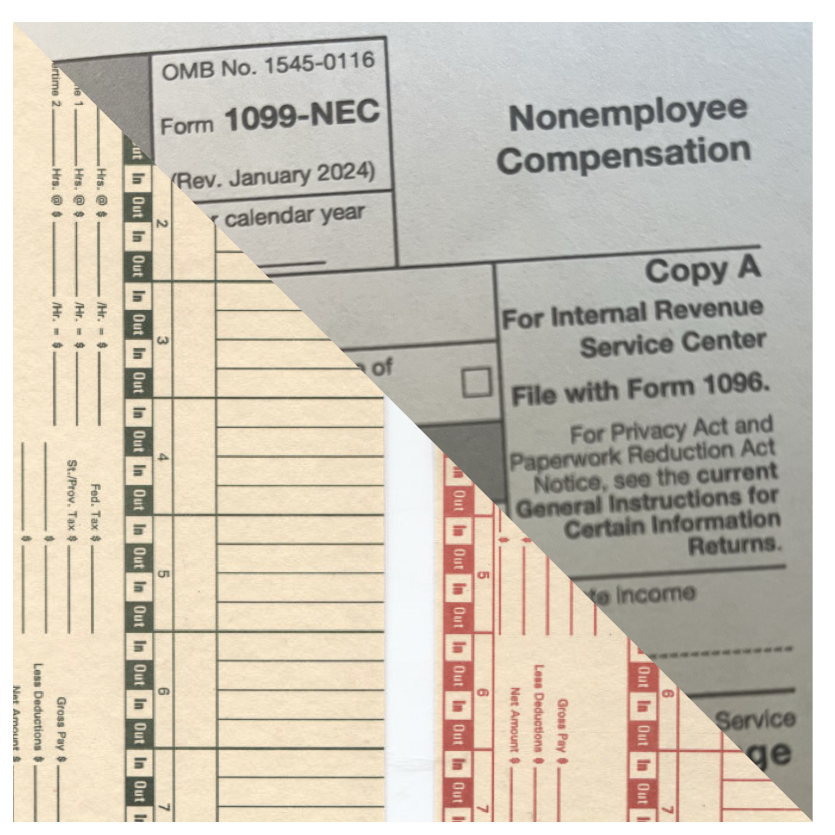Am I an employee or an independent contractor? Why does it matter?
In today’s job market it’s not unusual for Americans to juggle multiple jobs to make ends meet. Many people have a “side-gig” that provides extra income – often in marketing, sales, or other commission-based work. However, when tax day rolls around some workers receive an IRS Form W-2, while others receive an IRS Form 1099-NEC. The type of form you get isn’t just paperwork that you send to the government! It’s a crucial part of determining your rights and obligations and it applies to both employers and workers.
Who gets what and why?
An IRS Form W-2 Wage and Tax Statement, reports wages for employees. A person who receives a W-2 is an “employee”. On the other hand, an IRS Form 1099-NEC Nonemployee Compensation, reports payments to “independent contractors.” Independent contractors are not employees.
Employee: Defined
Generally, an employee is a person who works for a company or individual under an employment agreement and receives wages. The employer withholds several taxes from each payment to the employee: Federal, State, and Local Income Taxes, Federal Insurance Contributions Act (FICA) Taxes (Medicare and Social Security). Employees are eligible for benefits like Unemployment Insurance (UI).
Independent Contractor: Defined
Generally, an independent contractor is a self-employed individual who provides services under a contract – which ordinarily has a definitive start and end. Independent contractors receive income without any tax withholding, and are responsible for paying their own income taxes because of this. Independent contractors are usually ineligible for benefits like UI.
Why it Matters to Employees
Some employers may incorrectly label workers as “independent contractors” to avoid paying taxes like Federal Unemployment Tax Act (FUTA) and State Unemployment Tax Act (SUTA). While this saves the employer money, it can have serious consequences for mislabeled workers, such as losing unemployment eligibility.
Why it Matters to Employers
Incorrectly classifying workers can be costly for employers. Failing to properly classify workers and not paying the appropriate taxes may cause employers to face fines, penalties, and potential legal action.
How to Spot the Difference
Depending on your tax situation, separate government entities, such as your state government or the IRS, use similar but distinct methods of determining a worker’s status as an employee or independent contractor. Determining employee status is not black and white, but following these guidelines can help avoid issues down the line.
The IRS’s Three Key Factors
The IRS uses three key factors to help determine if a person is an employee. The more control a business has, the more likely workers are employees.
Factor 1: Behavioral Control
Behavioral control is the control a business has over how a worker performs their job duties. Examples of behavioral control include:
- Time Management – when work is performed, number of hours worked;
- Workplace Procedures – specific ways to speak with a client, enforcement of internal company policies on the worker;
- Location Restrictions – requirement to work at a specific location, such as a company office.
Factor 2: Financial Control
Financial control is the control a business has over how a worker receives compensation, tools, and supplies related to their job. Examples of financial control include:
- Frequency of Payment – when and how often a worker is paid;
- Reimbursement – whether a worker is reimbursed for job expenses;
- Source of Tools – a worker is more likely to be an employee if the business that hired them provides the tools and supplies for a project.
Factor 3: Type of Relationship
The type of relationship is how the worker and business view each other in the workplace. Ways to identify relationships include:
- Written Contracts – contracts without a defined end likely show a worker is an employee;
- Employee Benefits – workers receiving benefits are more likely to be considered an employee;
- Type of Service Provided – workers who provide the same type of services that the business does are more likely to be considered an employee.
The IRS’s Three Key Factors are Behavioral Control, Financial Control, and the Type of Relationship.
Indiana’s Definitions for UI
The Indiana Department of Workforce Development (DWD) Unemployment Insurance Employer Handbook defines an employee as “an individual who performs a service for an entity in the usual course of their organization, trade, or business and is compensated in some way for the services that they perform” (page 99).
A person is an independent contractor if they control how they do the job, their work differs from the business’s primary activities, and they perform jobs for various businesses or organizations as part of their profession.
In simple terms, if you have your own business or you provide a service that isn’t in the same line of work as the person who hired you, you’re probably an independent contractor. A sculptor hired by a beverage company to make a statue of their founder is a simple example of independent work. Here are two more examples that are a bit trickier:
Example 1: Bob is a sales consultant and owns his own consulting and sales business “Bob’s Sales, LLC”. John makes trinkets for his business “John’s Trinkets, Inc.” and hires Bob to sell his trinkets. John doesn’t have a quota for Bob and only requires Bob to sell his trinkets. Bob is likely an independent contractor.
Example 2: Henry is a marketing professional for trinkets and does not own his own business. John of “John’s Trinkets” asks Henry to sell his trinkets. John asks Henry to sell trinkets by phone call five days a week from 8:00 AM to 5:00 PM and requires Henry to sell at least 100 shipments of trinkets each month and Henry gets 20% of each sale. Henry is likely an employee because of John’s control over how Henry works.
A person is an independent contractor if they control how they do the job, their work differs from the business’s primary activities, and they perform jobs for various businesses or organizations as part of their profession.
Quick Reference Table
This table provides a quick comparison of the differences between an employee and an independent contractor.
| Characteristic | Employee | Independent Contractor |
|---|---|---|
| IRS Tax Form | IRS Form W-2 | IRS Form 1099-NEC |
| Tax Withholding | Taxes are withheld by employer (Federal, State, Local, FICA) | No tax withholding; responsible for paying own taxes |
| Unemployment Eligibility | Eligible for unemployment benefits | Generally not eligible for unemployment benefits |
| Work Control | Employer controls work process and conditions | Works independently; controls how work is completed |
| FUTA/SUTA Contributions | Employer pays FUTA and SUTA taxes | No FUTA/SUTA taxes paid by company; no unemployment coverage |
| Relationship Duration | Ongoing relationship; often long-term | Typically project-based or short-term contracts |
| Benefits | Eligible for benefits like health insurance, retirement plans | Not eligible for employee benefits |
What if I am still unsure?
You can submit to the IRS a Form SS-8, Determination of Worker Status for Purposes of Federal Employment Taxes and Income Tax Withholding. This extensive questionnaire will allow the IRS to help you make a determination on worker status.
Additionally, you can contact an attorney who can help you with determining worker status. If you would like to learn more about business compliance, contact our office and schedule your consultation!

